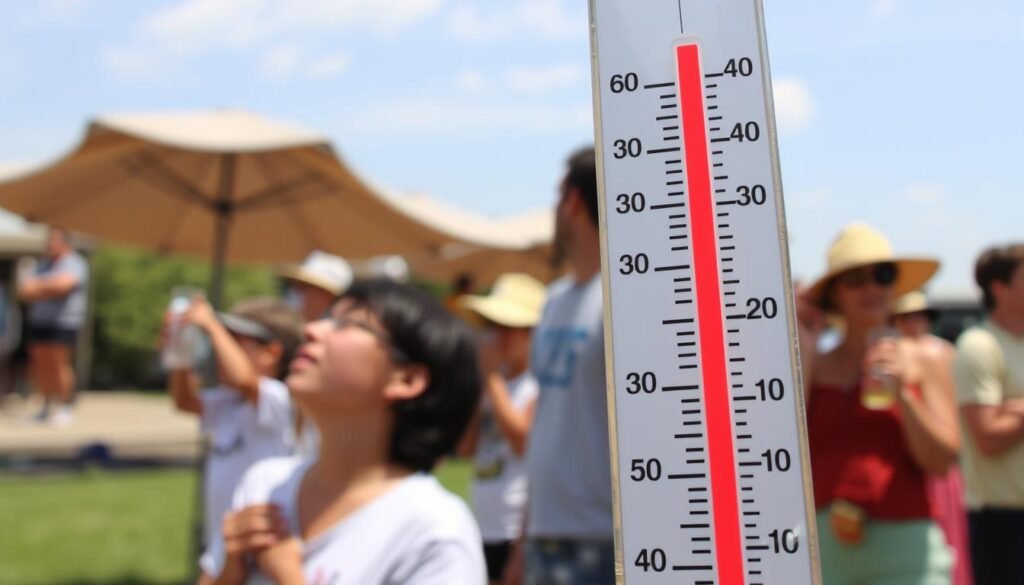As summer temperatures rise, knowing about heat advisories is key for public safety. A heat advisory warns communities about extreme heat and humidity coming their way. It helps people prepare and protect themselves and their loved ones from the heat.

Heat advisories give the public timely info to make smart choices and stay safe. They are issued when high temperatures and humidity could be dangerous. This can lead to heat-related illnesses and even deaths.
What is a Heat Advisory?
A heat advisory is a weather alert when temperatures might get very dangerous. Meteorologists issue these alerts to warn people about the risks of extreme heat. They also give tips on how to stay safe during a heat wave.
Defining Heat Advisory Conditions
The temperature that sets off a heat advisory varies by location. It depends on the expected high temperature and how long the heat will last. Usually, a heat advisory is given when the heat index hits at least 100°F (37.8°C) for a while.
Heat Index and its Role
The heat index, or apparent temperature, combines air temperature and humidity to show how hot it feels. Meteorologists use it to understand the real effect of high temperatures. When the heat index gets too high, a heat advisory or an excessive heat warning might be issued. This alerts people to take safety steps.
| Heat Index Range | Heat Stress Risk |
|---|---|
| 80°F to 90°F (26.7°C to 32.2°C) | Fatigue possible with prolonged exposure and/or physical activity |
| 90°F to 105°F (32.2°C to 40.6°C) | Heat cramps and heat exhaustion possible |
| 105°F to 130°F (40.6°C to 54.4°C) | Heat cramps, heat exhaustion, and heat stroke possible |
| Above 130°F (54.4°C) | Heat stroke highly likely with continued exposure |
Heat Advisory vs. Excessive Heat Warning
There are two main weather alerts for high temperatures: heat advisories and excessive heat warnings. A heat advisory means the heat index, which combines temperature and humidity, will hit 100-104°F. This could be risky for public health. On the other hand, an excessive heat warning warns that the heat index will go over 105°F. This is a big threat to the community.
The key difference is the level of risk and what actions are advised. For a heat advisory, people should drink plenty of water, stay indoors, and check on the elderly. But, an excessive heat warning means the danger is much higher. Authorities might open cooling centers or limit outdoor activities.
It’s important to know the difference and act accordingly. A heat advisory is common, but an excessive heat warning is serious. Heat-related illnesses like heat exhaustion and heat stroke are more likely during these times.

Knowing the difference between a heat advisory and an excessive heat warning helps you protect yourself and your family. Keep an eye on the weather forecast and follow what authorities say. This can keep you safe during dangerous heat waves.
The Dangers of Extreme Temperatures
During a heat advisory, extreme temperatures can be dangerous, especially for those who are more at risk. It’s important to know about heat exhaustion and heat stroke to stay safe. This knowledge helps protect those who are most vulnerable.
Heat Exhaustion and Heat Stroke
Heat exhaustion is a less severe heat illness. It shows as heavy sweating, dizziness, headaches, and nausea. If not treated, it can turn into heat stroke, a serious condition.
Heat stroke happens when the body’s temperature goes over 104°F. It brings on confusion, fast breathing, and even losing consciousness. Both heat exhaustion and stroke need quick medical help to avoid serious problems or death.
Vulnerable Populations and Risk Factors
Some people are more likely to get heat-related illness during a heat advisory. The elderly, young kids, and those with health issues like heart or lung problems are at higher risk. People who work or play outside, and those without air conditioning or social support, are also more likely to face health problems from the heat.
Knowing the signs of heat exhaustion and heat stroke is key. Taking steps to protect those at risk is essential during extreme heat. By understanding the dangers and risk factors, we can prepare and respond better to high temperatures.
Staying Safe During a Heat Advisory
When a heat advisory is in effect, it’s crucial to take proactive steps to protect your health and well-being. Understanding the importance of proper hydration, effective cooling techniques, and responsible outdoor activity precautions is key. This way, you can handle the extreme heat with confidence.
Hydration and Cooling Tips
Keeping your body well-hydrated is vital during a heat advisory. Drink plenty of water and avoid sugary or alcoholic drinks, which can make dehydration worse. Choose cool, refreshing drinks that help lower your body temperature. Also, taking cool showers or baths can help cool down, and using cool, damp cloths on your skin promotes cooling through evaporation.
Outdoor Activity Precautions
If you must be outside during a heat advisory, be extra careful. Limit your time outside and plan activities for cooler times like early morning or evening. Wear lightweight, light-colored clothes that reflect heat, and apply sunscreen to protect your skin from the sun’s harmful rays.
By following these simple yet effective strategies, you can stay safe and comfortable during a heat advisory. This ensures you can enjoy the summer without risking your health and well-being.

Conclusion
Understanding heat advisories is key to staying safe during hot weather. These advisories warn us of dangerous heat and the need to be careful. Knowing the difference between advisories and warnings helps us prepare and stay safe from heat-related illnesses.
Extreme heat can lead to serious health issues, like heat exhaustion or even heat stroke. It’s crucial to listen to these warnings and take steps to protect ourselves. This is especially true for the elderly, young kids, and people with health problems.
Keeping hydrated, staying cool, and avoiding being outside too long are important steps. By doing these things, we can keep ourselves and our communities safe.
Dealing with summer heat requires us all to focus on heat safety and being ready for heat advisories. It’s a personal and community effort. By spreading awareness and promoting summer safety, we can help everyone handle the heat better. This way, we keep our neighborhoods healthy and strong.


